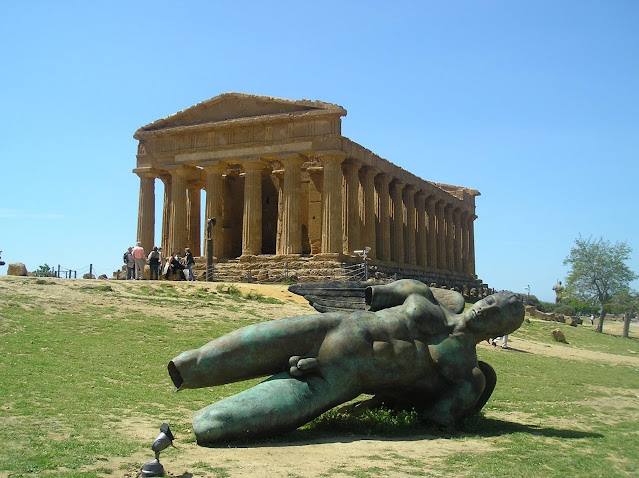Noto … Europe’s Stone Garden
When visiting Sicily a trip to the South East corner is a
must do, the landscape is very much different from the rest of the island yet
this small corner is rich in sights.
The towns of Syracuse, Caltagirone, Modica, Ragusa,
Palazzolo Acreide, Scicli and Noto have all been declared as UNESCO World
Heritage sites on the merits of their Baroque architecture and town planning,
the result of the rebuilding after the destruction of the 1693 earthquake.
Noto is a most beautiful Baroque city and has been a UNESCO
site since 2005, its nickname is “The Stone Garden of Europe”. It was lovingly
reconstructed after the earthquake by a Sicilian-Spanish aristocrat, Giuseppe
Lanza the Duke of Camastra.
The town fascinates visitors with its noble palaces and
churches.
Before you explore Noto it is worth a trip first to Noto
Antica. Here lays the ruins of the pre-earthquake town. Built on an arid
limestone ridge the site has views of the Province of Ragusa and Mount Etna. When
Giuseppe Lanza saw the ruins of Noto he decided to build the new town 16km to
the South. There is not much to see here but the ruins of the old town will
give you a sense of the devastation that the earthquake caused.
The new town of Noto was rebuilt using tufa stone that has
turned a honey coloured shade after years of sun. The town plan boasts open
wide streets with plenty of Piazzas. In the evening as the sun sets the
buildings glow as if golden and are floodlit at night.
The main street of Noto is the pretty Via Vittorio Emanuele which has many tempting cafes, boutiques and
gift shops, at one end on Viale Marconi (where we usually park) you will find the Giardino Pubblico (the public gardens),
here there are street vendors that sell local produce including honey,
preserves, pesto, sundried tomatoes and dried herbs.
As you walk along towards Via Vittorio Emanuele you will pass by an arch called the Porta Reale and thereafter the street
then becomes pedestrianised. This arch was built in 1938 and on top you will
see three symbols of a dog, a tower and a pelican, meaning respect, loyalty,
strength and sacrifice which symbolise Noto’s allegiance to the Bourbon monarchy
of that era.
Further along you will find some of Sicily’s most beautiful
buildings. Most buildings in Noto boast beautifully carved balconies with
buttresses.
In Piazza del
Municipio you will find the breath taking Duomo with its twin towers and it
is approached by a wide graceful set of steps outside. The Duomo has recently
been restored after its dome collapsed inside and now it is back to its full
glory. Opposite is the Palazzo Ducezio which
today is the town hall.
Also on this street you will find the Church of Saint Carlo
(Chiesa San Carlo), here for a small
fee you can climb the narrow spiral staircase up to the bell tower (campanile) where you will get breath taking
views which will create Insta-envy with all your Instagram followers.
Further down the street you will find Via Corrado Nicolaci, on this steep upward road is Palazzo Nicolaci di Villadorata dating from
1739. A walk up this road is a must
as the balconies on the Palazzo are exquisite, as you look up six of the
balconies have beautiful carved buttresses underneath. Sculptures of griffins,
galloping horses and bald bearded figures with chubby cherubs. The palazzo is
worth a visit for its stunning interior where you will feel like you are in a
real Sicilian palace and imagine the grandeur of times gone by.
Via Corrado Nicolaci
is also well known for another reason …..
In the third week of May the road comes alive during the
town’s annual Infiorata flower
festival. Locals and tourists in their hundreds ascend on to Noto to see
spectacular designs of petals that cover the entire road. It is an amazing
colourful sight to behold.
Worth a visit as well as Noto’s Teatro Comunale where a
thick velvet curtain swept aside in the foyer reveals a lovely auditorium, red
and gold, tiny and round, with plush velvet seats on the floor and honeycombed jewel-like boxes inserted around the walls.
Of equal
enjoyment is the gastronomy of the area, including seafood from the south
eastern coastline, meats, cheeses and wild greens of the countryside. But there
is one place that we always must pay a visit to …..
Caffe Sicilia on
Corso Vittorio Emanuele has been established for more than a century by the
family of Carlo and Corrado Assenza. The brother’s search for the highest
quality ingredients Sicily has to offer working to preserve the Sicilian pastry
making tradition. They create pastries from the recipes of Noto’s ex-monastery
Santa Chiara as well as their own recipes. Try their Giuggolena a sweet bar made from Sesame seed, Sicilian honey and
Sicilian orange zest. It is mind blowing. Also try their delicious granite
available in a wide variety of flavours.
Aside from the stunning architecture there is not many other
tourist attractions in Noto therefore I would suggest combining a visit with
the many other UNESCO sites and towns within easy reach or cool off on Noto’s
local beach Lido di Noto.
With budget airline Ryanair flying into Comiso airport
nearby, Noto and the South East of Sicily is now easily reachable for a
memorable stay in Sicily.
From Taormina the drive is approximately one hour and forty
five minutes through the winding roads of the Ragusan countryside.
If you enjoyed this post search my Blog archive for my post “Scicli”
in October 2015 and discover this equally beautiful Baroque south eastern town.
Photo Gallery
Thank you for following me at
White Almond Sicily Blogspot
You can also follow me on Facebook at
Email at WhiteAlmondSicily@Gmail.Com
for Travel Tips, Trip Advice and Recommendations
for Travel Tips, Trip Advice and Recommendations
Love Sarah x























